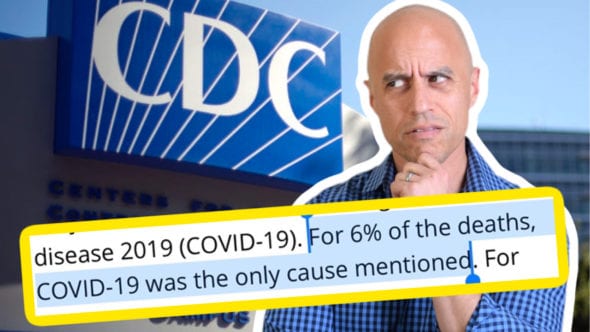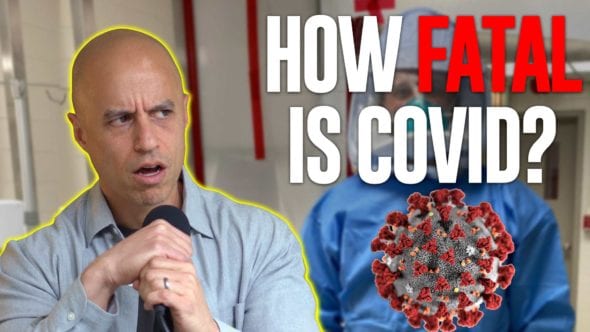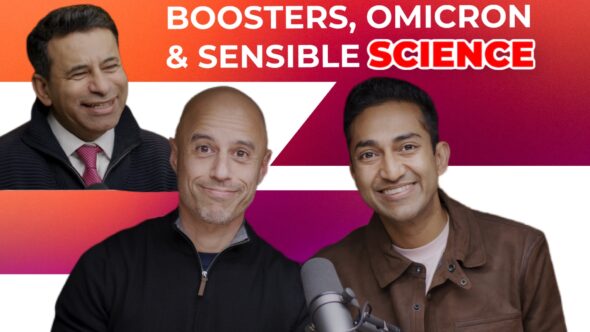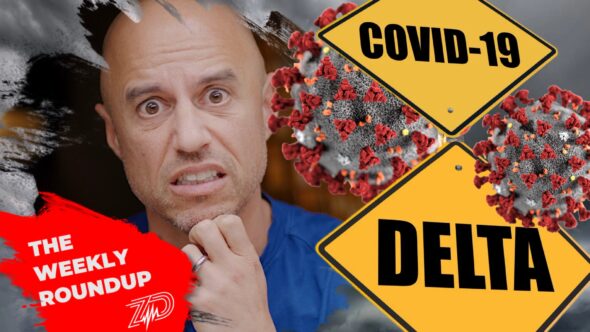We need to understand that the goal is mitigating, not eliminating, COVID-19 risk. And the risks of children missing school can be massive.
Here’s the resource and statement from the American Academy of Pediatrics.
Full Transcript Below (pardon any errors)!
Hey everyone, Dr.Z welcome to the live show. Whether you’re watching on Facebook or YouTube I want you to leave your comments because what I’m gonna talk about is not uncontroversial and I’m talking about kids getting back to school. So why is this so important? Why am I obsessing about this? Well, I’m a father and I am also deeply connected to a lot of pediatricians around the country who are seeing one of the big side effects of this pandemic, which is devastation to children and families and communities and social fabric that comes from taking children out of their social situation out of their educational situation, school, physically being present in school and trying this grand experiment of distance learning et cetera during the pandemic.
And it’s been an unmitigated disaster. Let’s be completely honest. It has not worked well. There are very few students who have benefited from the distance learning and what we’re seeing instead are the downside effects off this approach, which are increased anxiety and mental health disturbances in our children, the effects of lack of socialization. We’re social creatures and children are no exception. They’re hyper social.
And I’m seeing this in friends and family and others as well where children that are normally maybe a little borderline anxious, et cetera have lost it, just absolutely lost it. Throw that into the setting of parents then who are trying to get back to work or trying to work from home or whatever it is. The economic importance of that can’t be overstated and having children now at home all the time hey, you love your kids but there comes a point where it becomes a complete disaster. And what ends up happening then and that’s on the good end of things. On the bad end of things you have abusive households.
The lack of ability of teachers and outside sources to see what’s going on in terms of mental illness, suicidality, substance abuse, domestic abuse at home, because the ability to get out of the house is gone. And you what you end up with is a massive amount of harm. Now people will say but the pandemic, kids are are completely disgusting vectors of disease and that’s true for influenza and it’s true for stomach flu and it’s true for these kind of viruses. But you know what the science is starting to suggest and again we don’t have all the answers. The science is starting to suggest that this is not true for COVID-19. Children seem to get it less, they suffer side effects and complications from it less and they seem to transmit it less.
Now again more information may come out that may change that. But right now, that’s our state of understanding. That’s one of the few upsides of this pandemic is that children are largely spared, which means what’s the harm of what we’re doing? People seem to think that the goal is to keep every single person safe from every single thing. It’s a culture of safetyism as they call it. So we do everything at any cost to keep people safe.
Well, what’s the cost of that? It’s actually harming people. And in the case of our children, the harms of keeping them home, the harms even of having them go to school two days a week in this rotating way are innumerable. They’re not getting educated and they are not getting socialized and there’s increasing all the problems we just talked about. So all that being said, what’s the answer? Well, it’s interesting that the American Academy of Pediatrics actually put out a statement recently which I’ve linked to in the description of this video. That basically said, it is of paramount importance that children be physically present in school. And here’s a million things that we can do to make that work.
And I agree 100% with my pediatric colleagues 110%. Now, this is gonna upset a lot of teachers. It’s gonna upset teachers unions, it’s gonna upset some parents who are afraid the children are gonna bring home diseases, COVID-19 to vulnerable adults and grandparents. But what I’m saying right now is this is not about eliminating risk. This is about mitigating the most risk for the most people and having the highest benefit. And having children in school is the answer to that and you can mitigate the risk for the adults involved and the children.
Remember, there’s this small risk that children will get very sick from COVID-19. There’s a small risk that they’ll get this multi-system inflammatory syndrome of children, which is so rare you guys. Still it is much more likely they will get hit by a car crossing the street than get MISC. So we have to put risk in context, right? The advantages of school, getting fed, having a stable environment, having the socialization, having the structure and the education, this particularly matters for children of economic disadvantage or racial minorities.
They disproportionately suffer when you take away the structure and the regular meal and all of that off school. What is the harm we’re gonna see which we’re gonna pay for eventually in needing increased police for the crime that happens and the poverty that happens and all the other things. We really have to look at this rationally and cleanly and the AAP statement goes through. Now, here are some of the things like they were talking about in order to mitigate the harm and the danger of potentially sending kids back to school. One is okay, what’s the deal with social distancing? Well, first of all it matters what group of kids you’re talking about.
If you’re talking about pre-K good luck social distancing pre-K kids. And by social distancing, we’re talking about CDC. Which is like six feet, good luck is not gonna happen. Pre-K is not gonna happen. So what do you do? And by the way, daycares have been open, right? For essential workers and all of that. What’s going on? Well, the adults wear masks. They try to do the best they can washing the kids hands. Cohort children in other words, have a group a class that stays together but doesn’t really cross over with other classes. So you’re reducing this sort of inner personal contamination as much as you can and keeping the children together. Maximizing outdoor spaces because listen, let’s be completely clear.
It’s getting increasingly clear that this thing does not spread well outdoors, it just doesn’t. So get people outside as much as you can. It’s also easier to distance outside. Play is important. Getting kids out in unstructured play is important. So there’s so many benefits to being outside. So you can do that with the pre-k crowd. And now remember that if teachers have a lot of comorbidities are at high risk you need to have considerations for them. This is very important and their mental health as well. They’ve been thrown in a crazy situation, trying to do distance learning and all of this, it’s very stressful. But we have to remember that we kind of all are trying to do the most good for the most people. So with pre-K, again social distancing not as important, but you can do these techniques. Now for elementary, kindergarten that kind of thing. The idea of a six foot social distance for children is actually gotta be balanced by the fact that that’s gonna disrupt their ability to actually physically be in school without a lot of disruption.
And that means that maybe an AAP says this, maybe three feet is better. Maybe something that’s less ridiculous and it may be enough for kids. Now, with younger kids, you can anybody over two years old, you shouldn’t be putting a mask on someone two or younger that’s insane and it’s risky and don’t do it. But over that age, they might be able to wear masks. You have to weigh the downside of them constantly touching their face, which means surfaces then have to be cleaned and hands have to be washed. But there can be education around this now obviously with considerations for special education and kids with special needs. That’s a case by case thing that can be very very difficult. But again, having them be in school is very, very important. So with kids, I think we need to let go of this idea that six foot social distance is gonna happen. But continue to cohort them together so that you’re not having a lot of cross contamination across classes and outdoors as much as possible, right? for eating in cafeteria and that kind of thing.
Again, cohorting, going in shifts that kind of thing is probably the best thing you can do to reduce spread. Now for adults again masking. You even wonder and this is me speculating whether using higher grade N95 level masking for teachers at risk makes sense because that is a much more occlusive seal that protects the wearer more. The other the surgical mask and the cloth mask are really a lot about protecting others from your droplets. So for teachers maybe we ought to be investing in that. I mean, we’ve spent trillions of dollars bailing out the economy and big companies and large hospitals. Can’t we spend some money on our teachers and our education and our children and our future? That’s kind of important, I would think. So that’s sort of pre-K, kindergarten, elementary school. Now, when you get into the secondary schools, middle school, high school. This is where it becomes interesting because social distancing does matter more. So you do wanna try to keep the desks apart, cohort classes. It’s tough because people are rotating classes. Maybe we ought to be rotating the teachers instead of the classes themselves. There are different things again, outdoor education but in secondary school and high school, universal masking.
So I’ve changed my sort of messaging unmasking a little bit, I think cloth masks are still not ideal. I think they’re just not ideal. But the thing about masking in general is it only really seems to work if everybody’s doing it because you lower the overall ambient viral load in the room. If you have a room that isn’t wonderfully circulated and all that or you’re not outside universal mask, by the way masking on trail systems and in parks and things like that, that’s just stupid and we need to stop even talking about that, you wanna surefire way to get people to stop wanting to ever wear a mask and get open rebellion make mandates that make no sense to people. So but universal masking in secondary and high school can protect students but it will protect teachers and lower the overall risk. So that’s not a massive intervention you guys like it can be done. Get the kids to wear stylish cloth mass whatever, they can be cool with their masks, I don’t know man. All I know is I kind of like the private school approach where kids wear uniforms so there isn’t all that distinction. But whatever, I mean if we all wear a surgical mask, it be kind of an interesting equalizer, wouldn’t it? But maybe I’m just projecting my own nerdy childhood experience.
This all being said, it is remarkable that AAP has come out with this recommendation and I back it. Now what I wanna hear is from teachers. I wanna hear from people that have a contrary opinion on this but I want you to give me good evidence for why we should listen to you. Because right now, okay, I’m gonna really lay this out. This is an emergency. Our children are in crisis. And I think any parent right now can kind of feel that. It’s really, really bad. And I’ll tell you the story of my own children, like they were pulled out of school like everyone else in California, in March or February whenever it was and they’ve been doing the distance learning thing. For my third grader, it was a disaster. She’s an introvert as it is and the teacher had no plan for how to do distance learning, was completely discord and it’s not her fault. This is all new. And it was entirely useless. So they did home study books and things like that. No socialization, increased anxiety in the child and just not good. Well and then my older child who is in sixth grade had a better distance learning experience but still the socialization, she’s a hyper social child, really, really bad. So we’re seeing a little bit of behavioral stuff, anxiety, little acting out. Well, so what do we do when summer started? We said, all right, we’re willing to take a degree of risk. Put them in a ninja camp where they go with other kids and do obstacle courses and physical activity and have a cohort of children that are, screened before they enter with temperature testing, which by the way is a fricking placebo.
So we know most people, especially children are asymptomatic. A lot of people are asymptomatic they don’t have fevers and so screening by fever, it might pick up a few people but really it’s not. You almost wanna screen by loss of the sense of smell. People are talking about that is a little more sensitive than fever. But so they scan them with the infrared detector. When they come in they do a questionnaire and the bottom line is this and whether you’re talking about ninja camp or are you talking about school, if you have respiratory symptoms or fever you should not go to school period and we ought to have a social covenant where that’s the case. Any kid with any of those symptoms get sent home, you just wanna use common sense about this and educate people about it. So we send them to the ninja camp. They spent all morning exercising, playing with other children, competing doing this thing and it has been a night and day change. Children with physically with other children and teachers who are wearing facials and masks, right?
The kids are not, because they’re exercising in an open space but it’s still the risk is not zero, what’s happening? Okay? First of all, no one’s gotten sick, knock on wood. Second of all, their attitude level of anxiety, general demeanor has transformed overnight and this is anecdote but I bet you others would find very similar findings. And our American Academy of Pediatrics is saying exactly this because guess who’s seeing the downside on our children’s health, mental and otherwise? Our pediatricians. So, the bottom line is this guys. We need to get our kids back to school. We need to do it safely and thoughtfully. We need to read those AAP guidelines. We need to listen to our teachers, right? I’m not sure we need to listen to our teachers unions. But I think we need to listen to our teachers. See where my bias is. Because let’s be honest we all know there are lazy teachers out there like lazy doctors and lazy nurses who are just phoning it in, who are honestly they love this because it’s great, it’s great. We can’t allow that this is about our children. All right?
And for the great teachers out there who are legitimately scared for their health, we need to make provisions for them and we need to hear them, okay? That’s all I gotta say. Please share this video, leave a comment and subscribe if you believe in what we’re doing and I love you guys stay well. I’m looking forward to the school year starting without massive disruption, without two days on, three days off or some nonsense like that. Let’s keep our children safe while remembering the risks of not having them physically in school. All right guys I love you. We out peace.
Category
- The ZDoggMD Show (818)
- Featured Videos (189)
- Doc Vader (142)
- Against Medical Advice (128)
- Medical Humor (95)
- Public Service Announcements (87)
- Music Parodies (74)
- Nurses (59)
- Meditation (46)
- The VPZD Show (38)
- ZVlogg (36)
- ZTalks (28)
- ZBlogg (24)








